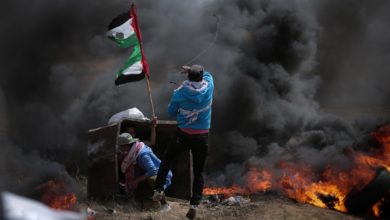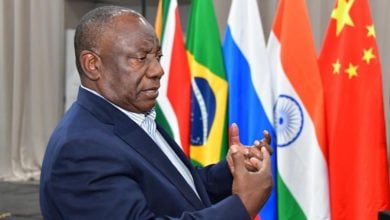Since 1994, South Africa has been governed by the African National Congress, which has maintained its “Tripartite Alliance” with the South African Communist Party and the Congress of South African Trade Unions.
At the end of December 2013, shortly after Nelson Mandela’s passing, this alliance experienced its most significant split in 20 years. The National Union of Metalworkers of South Africa unanimously passed in a Special Congress a resolution to stop supporting the ruling African National Congress in the 2014 elections. Instead, the union would explore the creation of a mass revolutionary socialist workers party, and has called for the large and powerful national labor federation, COSATU, to follow suit and assert its independence from the ruling ANC.
The metalworkers’ union — which goes by the acronym NUMSA — is not the first group to break its alliance with the ANC in the name of advancing working-class interests. The social movement-oriented Democratic Left Front was formed in 2011. The Workers and Socialist Party, which grew in the wake of the police massacre of striking miners at Marikana, was formed in 2012. The populist Economic Freedom Fighters, led by former ANC youth leader Julius Malema, was formed in 2013. Other breakaway unions and social movement organizations have split from the ANC-led Alliance in recent years.
What makes the NUMSA split so significant is that the union is the largest in the country — representing 338,000 workers — with a long and militant history. It has long been led by avowed communists.
The South African Communist Party
The South African Communist Party has a long and powerful history of struggle in the country. It became a mass party in the battle against Apartheid, earning leadership positions in the liberation struggle and trade unions because of its political clarity, internationalism and the self-sacrifice of its members. Since the overthrow of Apartheid, which did not overthrow capitalism, the SACP has functioned in Alliance with the ANC and the labor unions, holding influential positions in the capitalist state.
While communists in general do not take executive positions within the capitalist state, and instead fight for the complete political independence of the working class, the SACP argues that the tasks of the country require a different strategy.
The SACP, along with its Alliance partners, defines the current stage as one of National Democratic Revolution. The SACP defines this revolution as “the national liberation of the African people in particular, and the black people in general, the destruction of the economic and political power of the racist ruling class, and the establishment of one united state of people’s power in which the working class will be the dominant force and which will move uninterruptedly towards social emancipation and the total abolition of exploitation of man by man.”
The SACP’s alliance with the ANC, which continues their united front against Apartheid, is an alliance of capitalist and working-class forces. The SACP says that the Alliance is a site of struggle for revolutionaries, in which the working class must fight for leadership to ensure the National Democratic Revolution goes in a socialist direction.
But for the working class to become the dominant force in society, the domination of the capitalist class, and imperialism, must be shattered. The notion that socialism can be introduced “uninterruptedly” through reform and negotiation, is an illusion.
After 20 years, there is growing frustration among the South African working class that the country has not advanced towards social emancipation, and instead has seen the consolidation of a new capitalist system. The metalworkers’ union argues that the Alliance strategy has in fact tied the hands of the working class, and that the SACP — despite its rhetoric — has become deeply so embedded in the state that it cannot function as a center of revolutionary initiative.
Entrenched capitalism
At the base of the debate in South Africa is the immense pressure being asserted by the neoliberal economic direction adhered to by the ANC in the post-1994 period. The crises of poverty, unemployment, corruption, HIV/AIDS, and the deep ties between the ANC and capital have called into question whether the Alliance remains a vehicle for the revolutionary process.
To say the situation is “worse off” today than under the brutal legal system of Apartheid, as many do, is simplistic and wrong.
Nonetheless, South Africa has a very high unemployment rate of 25 percent, and for those under 35 the rate is 70 percent! Add this to inequities in education and healthcare, the lack of land reform, poor social service delivery, the continued hardship and segregation of Apartheid townships, and the picture is indeed quite bad for working people.
In 2007 and 2009, ANC conferences recognized — at least rhetorically — that the current economic reality was out of step with the stated vision of the ANC, and that a new phase was necessary to encourage development and combat inequality. But the rhetoric was not matched with a coherent and successful program of struggle against capitalist inequality.
Instead, the 2012 police massacre of striking miners at Marikana became a galvanizing event in South African working-class politics. The massacre recalled the anti-worker repression of the Apartheid era, demonstrated the continued rule of the corporations, and revealed the shortcomings of the leadership of the ANC, the South African Communist Party and COSATU. All lost credibility for their failure to condemn and go after the police and government officials responsible for the massacre.
Makings of the split
This state of affairs, and its divergence from the vision of the National Democratic Revolution, has increased the restiveness among the South African working class, and this has been reflected inside the Alliance structures as well.
The recent issuance of the ANC’s “National Development Plan” brought the crisis in the Alliance to a boiling point. For the metalworkers’ union, the Plan showed that the ANC would maintain its neo-liberal direction under left-sounding rhetoric. The SACP and other left-leaning supporters admit the document is flawed, but say it contains important benefits to the working class and provides a basis for a coherent and radical direction.
Since then, the political battle between the metalworkers’ union and the SACP has only escalated. The SACP says the union leadership is using revolutionary rhetoric for personal financial and political gain. NUMSA claims that the SACP has betrayed the interests of the working class.
In general, communists fight for the highest possible degree of organizational unity against the ruling class. Needless divisions are nothing to be celebrated. But in this case, NUMSA’s criticism of the SACP appears to be justified.
The strategic vision of NUMSA shows considerable promise. NUMSA plans to build a united front to bring together the struggles of workers, regardless of how they vote, on the job and in the townships, with the explicit intent to fight for socialism.
South Africa has many revolutionaries, but no real revolutionary center. NUMSA’s proposed model is to create a site where broader unity among revolutionaries can begin to take shape.
To say that the SACP and ANC have been entirely captured by neoliberal capitalist interests is an exaggeration. There are genuine militants and revolutionaries in both organizations, and the PSL hopes that the escalation of class struggle in South Africa will provide an opportunity for the best traditions to reemerge within the SACP.
We welcome NUMSA’s new initiative as a historic and much-needed advance by the South African working class. It has the potential to dramatically deepen the struggle for socialism, and strengthen revolutionary forces in South Africa and elsewhere.






